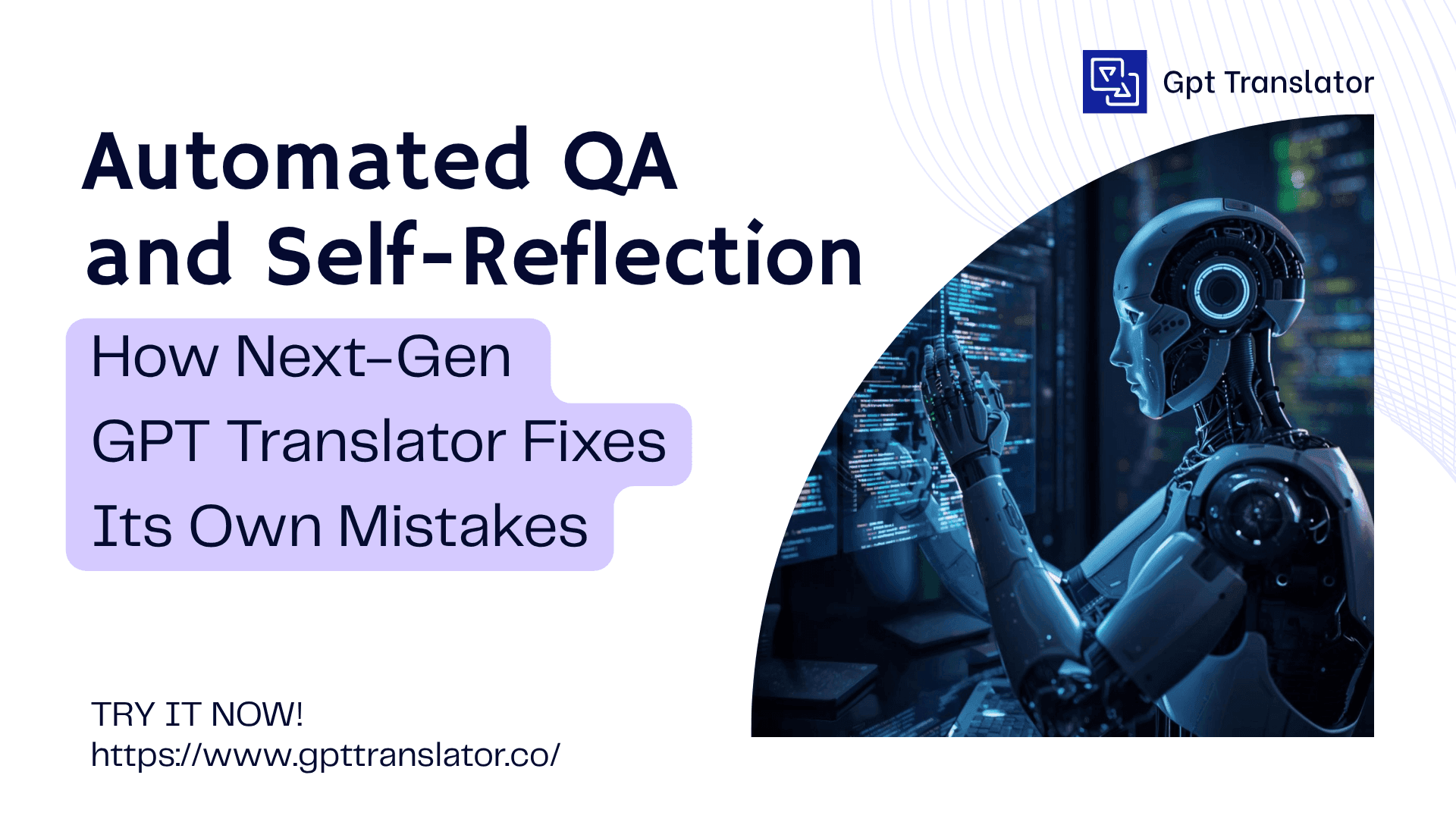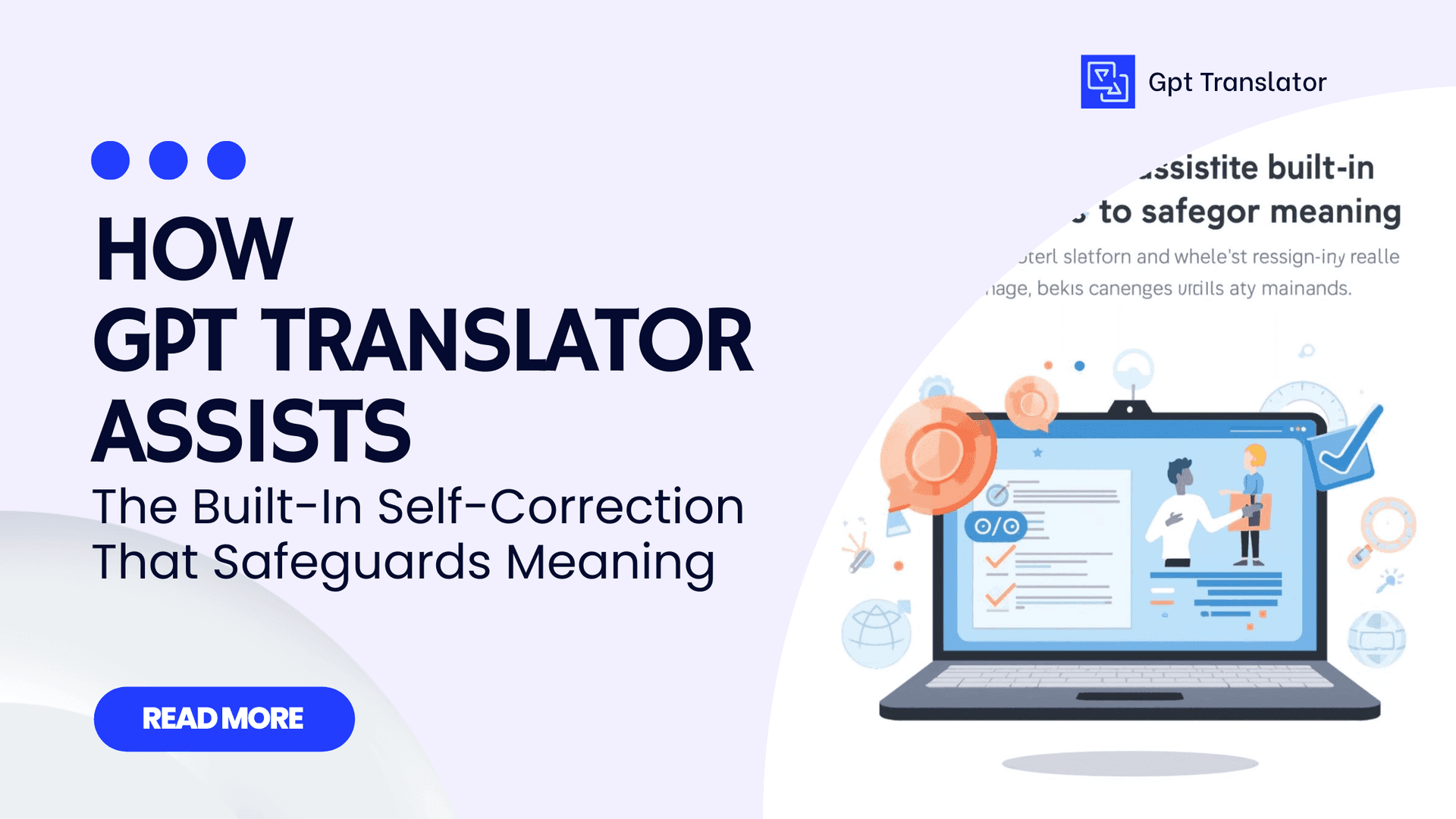Automated QA and Self-Reflection: How Next-Gen GPT Translator Fixes Its Own Mistakes
Automated QA and Self-Reflection: How Next-Gen GPT Translator Fixes Its Own Mistakes

The Problem: Even the Best Translation AI Makes Mistakes
Every business wishes to have no mistakes in translations but even the best AI tools can produce errors. Machines are interpreting the tone incorrectly. They are selecting the wrong technical terms. They are not catching the nuances of the situation. The main problem is not the translation but the quality control that is absent. If companies depend on manual QA, the process becomes tedious and costly. The teams will have to scrutinize every file word by word. Such a model cannot suffice for the pacing of the industries like finance, healthcare, e-commerce, law and tech which are always moving fast. Another point is about uniformity. On one day you may receive a flawless translation and the very next day you may receive an inconsistent one. Without a mechanism that checks its own output errors remain unnoticed. This is the reason why companies are reluctant to make the leap of scaling content globally without taking a risk. This is where the next-gen tools come in, powered by GPT translate, ChatGPT translate and sophisticated AI translation quality check systems. They do not sit back and let humans rectify the errors. Instead, they find the problems by themselves.
The AI Software Solution: Automated Quality Assurance Translation That Self-Corrects
The contemporary development of AI translation is mainly focused on quality not speed. Modern systems use intelligent loops of self-reflection to rate translations from different perspectives. This is the contrast with the traditional machine translation engines. Rather than providing just one output and halting, they keep re-testing the translation until it reaches a higher quality standard. Suppose you are translating a user manual. The initial translation may not be bad at all but the AI then verifies the tone. It matches the terms used. It looks at the syntactic structure. It checks the accuracy of the translation. If there is an issue with any portion, the AI will perform the task again. The checking and enhancing of the translation keeps going until it reaches the state of being coherent, understandable and carrying the same meaning with the original text. This is why GPT translation accuracy and modern automatic QA systems have such an incredible quality. They introduce an additional level of smartness in the translation process. They not only give text but also communication that is validated, improved and refined.
How GPT Translator Assists: The Built-In Self-Correction That Safeguards Meaning

Mini Case Studies: Real-World Proof of Automated QA in Action
Case Study 1: A Global Retail Brand Fixes Product Descriptions Automatically
A fast-growing e-commerce company was harassed by the problem of inconsistent product descriptions in five different languages. Some translations were too literal while others were too formal. The team was spending hours every day on manual error correction. After the transition to GPT Translator, the company reported significant progress. The self-reflecting system checked its own translations, rectified tone-related issues, and made sure the terminology was in line with the brand’s voice guide. What previously took a team several hours for each batch was now down to only a few minutes for the final check. Consumer participation was boosted as the descriptions became clearer, more human-like, and culturally accurate.
Case Study 2: A Healthcare Agency Cuts Down on Compliance Errors
A healthcare provider that translated patient information materials was subject to legal ramifications anytime there was a tiny inaccuracy. The team was required to carry out a manual check of every document to guarantee that it was compliant with medical standards. ChatGPT translate with built-in QA checks completely overhauled the workflow. The system automatically did the terminology comparison, flagged the risky phrases and corrected unclear medical terms. The AI even rewrote the sensitive instructions in such a way that they could not be misinterpreted. The end was that the agency cut down on its translation mistakes by more than 70 percent and the communication between the patients and the agency was safe through the use of different languages.
Case Study 3: A Finance Firm Increases Accuracy for Cross-Border Reporting
A finance company was frequently involved in the complex task of reporting in multiple markets. One simple mistake in the use of a term could lead to problems with the authorities. The drafts often contained errors before the company decided to resort to GPT translation accuracy tools. The new automated QA system assisted the finance firm in detecting misaligned terminology and inconsistencies even before the reports were exported. The AI checked the accuracy of the financial terms, did the possible interrelations of the abbreviations and made the text clearer without involving human intervention. The team has developed confidence in the translation process now and as a consequence their compliance burden has been significantly reduced.
Automated QA and Self-Reflection Are New Imperatives for Businesses
Today, the world of communication for businesses is such that even in the case of this second-largest benefit of all, the reproach of slow, difficult and wrong communication would still be valid. The death of a message is usually caused by the combination of mistakes leading to misunderstandings, damage and even lawsuits. Self-correcting AI translation, powered by GPT Translator and advanced AI translation quality check systems, ensures that companies stay ahead. This technology catches errors before anyone sees them. It protects meaning. It strengthens clarity. And it boosts trust. Human assistance is needed less and less; AI gets promoted to the first line of defense instead.
A More Human-Centered Way to Use AI

Incorporate Automated QA into Your Translation Process
Translation quality is a factor that can no longer be neglected if your company is increasing its global presence. Automated QA, self-monitoring and cutting-edge GPT Translator technology provide a safer and more efficient method for you to communicate through different languages. It is the moment to leave behind the simple tools and to welcome the translation system that assesses and refines its output. Your message gets clearer. Your staff gets quicker. Your communication gets more powerful. With the intelligent, self-correcting translation, powered by the next generation of AI, you can start to improve your multilingual communication right now!


